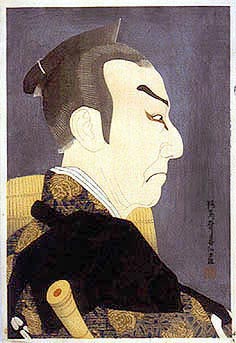

NATORI Shunsen (名取春仙)
|
 Natori Shunsen (名取春仙) began his art career as a Nihonga-style painter (painting in "Japanese style" as opposed to yôga or "western painting"), but abandoned it in 1919. He turned to woodblock print design in 1915 and began his association with the publisher Watanabe in 1916. He is most admired for his series Shunsen nigao-e shû ("Collection of Shunsen Portraits"), comprising thirty-six portraits of actors that were issued by Watanabe from 1925 to 1929, initially through monthly subscriptions, each inside a folder.
Natori Shunsen (名取春仙) began his art career as a Nihonga-style painter (painting in "Japanese style" as opposed to yôga or "western painting"), but abandoned it in 1919. He turned to woodblock print design in 1915 and began his association with the publisher Watanabe in 1916. He is most admired for his series Shunsen nigao-e shû ("Collection of Shunsen Portraits"), comprising thirty-six portraits of actors that were issued by Watanabe from 1925 to 1929, initially through monthly subscriptions, each inside a folder.
The critical consensus today is that Shunsen's actor portraits of the 1920s are the finest of the shin hanga movement. Shunsen continued working into the 1950s, but his final set (Shin han butai no sugata-e, "New Portrait Prints of Actors on the Stage") published circa 1951-54 was not as successful, despite some attractive designs.
The image at the top right depicts the actor Kataoka Nizaemon (1857-1934) in the role of Kakogawa Honzô from the play Kanadehon chûshingura ("Writing Manual of the Treasury of Loyal Retainers"). The print is signed Kajichôsai Shunsen ga with a square seal reading Shun and the approval seal Natori in the lower left margin. Printed with a silver mica ground, it was issued in an edition of 150 in 1927.
 Honzô is shown disguised as an itinerant monk (komuso), his bamboo flute (shakuhachi) visible at the lower left and his sedge hat (amigasa) — used to hide his face — behind him. It is the moment in the play when Honzô, having followed his wife Tonase and daughter Konami, reveals himself at the house of Yuranosuke, father of Rikiya, Konami's fiancé. Honzô will prevent his wife and daughter from taking their own lives after the shame they have suffered from the cancellation of the marriage ceremony due to misunderstandings over Honzô's actions earlier in the play. Honzô will soon die at the hand of Rikiya in sacrifice for his family. Shunsen's portrait is austere, evoking the mood and character of the self-sacrificing Honzô.
Honzô is shown disguised as an itinerant monk (komuso), his bamboo flute (shakuhachi) visible at the lower left and his sedge hat (amigasa) — used to hide his face — behind him. It is the moment in the play when Honzô, having followed his wife Tonase and daughter Konami, reveals himself at the house of Yuranosuke, father of Rikiya, Konami's fiancé. Honzô will prevent his wife and daughter from taking their own lives after the shame they have suffered from the cancellation of the marriage ceremony due to misunderstandings over Honzô's actions earlier in the play. Honzô will soon die at the hand of Rikiya in sacrifice for his family. Shunsen's portrait is austere, evoking the mood and character of the self-sacrificing Honzô.
The image on the lower right depicts the actor Ichikawa Ennosuke (1886-1963) as the robber Ikuda Kakudayû in the play Tôyama seidan, performed at the Shôchiku-za, Asakusa, Tokyo in 1926. A photograph exists from February 1926 showing the actor in the same pose, so it is possible that Shunsen modeled his design after the photograph. The artist's signature and seal (Kajichô) are at the upper right near the annotation that gives the date (Shôwa ninen shunyô saku, "made in the spring of the second year of Shôwa"). Watanabe's seal (Watanabe kô, "made by Watanabe") is at the middle right edge, while an approval seal reading Natori is at the lower right.
Shunsen's composition is a bold portrayal — inspired by the performance of Ennosuke, which was said to have caused a sensation. The shading used to model Kakudayû's face and the foreshortening of the figure clearly demonstrate western artistic influences, although there is some flattening of space in the blue area of the shaved head. Shunsen has successfully captured the intensity of the robber through his stare (mie) and the diagonal placement of the lance parallel to the right side of Kakudayû's face. The black ground helps to establish a menacing atmosphere, and it provides a strong contrast with the dark brown and yellow checked kimono. It is certainly a memorable portrait.© 1999-2020 by John Fiorillo
BIBLIOGRAPHY
- Halford, Aubrey & Giovanna: The Kabuki Handbook. Rutland & Tokyo: Tuttle, 1956, pp. 138-165.
- Stephens, Amy Reigle (Ed.): The New Wave: Twentieth-century Japanese Prints from the Robert O. Muller Collection. London & Leiden: Bamboo Publishing & Hotei Japanese Prints, 1993, pp. 161-164.
- Schaap, Robert: "The Front Cover," in: Andon 38 (vol. 10, no. 2), 1990, pp. 69-70.
- Smith, Lawrence: Modern Japanese Prints 1912-1989. London: British Museum Press, 1994, p. 32 & plate 42.
- Natori Shunsen. Exhibition catalog, Kushigata City, 1991, plate16 & 30.
- Toledo Museum of Art: A Special Exhibition of Modern Japanese Prints. Toledo, Ohio: 1930, figs. 135 & 148.
Viewing Japanese Prints |